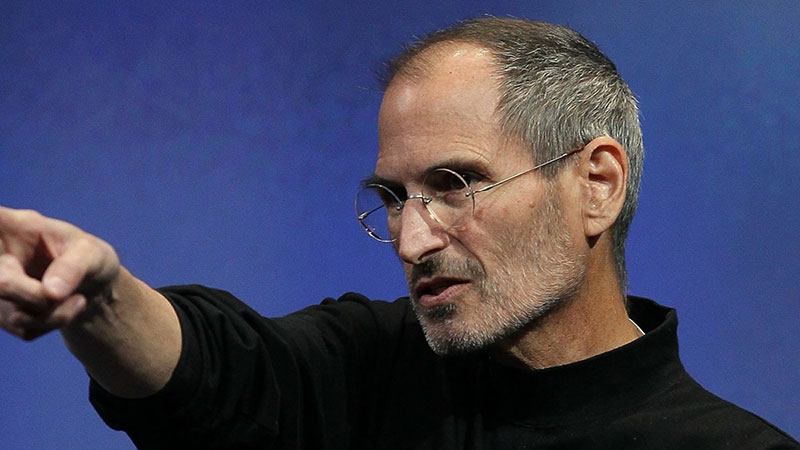It cannot be denied that Steve Jobs was a very successful entrepreneur and a visionary in the tech world. That success was achieved, however, in an unconventional and disruptive manner, demonstrated in business interactions, and communication with people in general.
In his biography, and according to various other credible sources, he was unorthodox and atypical in the way he responded to customer input. He also proved to be different in the way he dealt with his team members and the way he handled business relationships.
People may observe Steve Jobs’ autocratic leadership style and headstrong manner and think this is the key to his success in Silicon Valley. However, being headstrong is unnecessary for successful management. Although being headstrong was a trait that Steve Jobs exhibited, it was not the key to his success in creating one of the most successful companies on the planet.
There are no secret formulas for perfect management as situations may arise for which we cannot be prepared. There are a few tips and tricks on how to be a successful leader for aspiring entrepreneurs, but it isn’t recommended to imitate the leadership style of Steve Jobs when considering a business management startup strategy.
The Style of Steve Jobs’ Leadership

In 1985, Apple Inc. experienced disappointing sales and a plummeting stock price. This was deemed, by Apple’s then CEO John Sculley, to be the result of Steve Jobs being headstrong and narrow-minded in his strategic vision for the company.
This was concerning project Macintosh, the venture Steve Jobs was responsible for at the time. As a result, Steve Jobs was fired from the company he co-created.
Moving on, Steve Jobs set up his own company called NeXT, developing computer hardware and software. He also invested in Pixar Animation Studios (then known as Graphics Group).
He bought the company for $5 million from Lucasfilm and became the company’s largest shareholder and CEO. In 1997, NeXT was sold to Apple and Steve Jobs was rehired, this time as CEO, working for a salary of $1 a year.
This time around, the projects he developed like the iPhone and the inventions he produced saw an increase in sales and a rise in stock price. Apple was ahead of the game, providing simple to use but beautiful product designs that won consumers over worldwide.
The company was riding on the wave of a developing internet and leaving its competition behind. Under Steve Jobs’ autocratic management, Apple had become one of the most successful companies in history.
Steve Jobs is considered to have led his company in an autocratic manner, as something of a dictator, making all the management decisions himself. This showed a lack of trust in his employees and made him unpopular with his team.
Despite this apparent lack of trust, Steve Jobs knew the importance of taking business risks and as a result, made many mistakes in his career. The genius was that Steve Jobs was the first to learn from his mistakes through his innovative ideas.
Why It Won’t Work for You
There is no doubt that Steve Jobs was successful and that he used unconventional methods along the way in his path to success. Steve Jobs’ leadership style worked for him but is considered by many to be high-risk in terms of business strategy and employee relations.
Here are some of the accepted startup principles Steve Jobs did not adhere to and why you should:
Delegation
As a business grows, additional tasks need to be completed and more responsibilities need to be addressed to ensure the business runs smoothly. Enlisting the help of others by delegating certain tasks or assigning specific responsibilities is a way to share the load.
Due to Steve Jobs’ autocratic leadership style, delegating tasks or responsibilities was not an option. With a larger business, he was forced to assign some responsibilities elsewhere but only when absolutely necessary. His reluctance to trust others was because he wanted to be involved at the forefront of every new venture, including product design and business strategy.
Although this sounds like a good thing, taking on too much responsibility as an individual can have negative consequences. It can be detrimental to a person, and even the business could suffer.
Train and Invest in Staff
For most businesses to be successful they need to be operated by individuals who have received some kind of formal training in management techniques. The majority of staff will thrive and develop under such training.
Steve Jobs never had any formal training. This makes his accomplishments even more remarkable and exceptional. This may well be possible for someone as gifted as Steve Jobs, but the majority of people require an investment in training.
Formal education allows them to carry out their tasks and responsibilities successfully. When it comes to leadership and management, this is especially important.
Nurture Business Relationships and Networking

It is important in any business, especially startups, to have good relationships with potential partners and stakeholders. This can give the company a level of security and support that may be necessary for maximizing business potential and long-term growth.
Steve Jobs had feuds with many potential partners, including John Scully and Bill Gates, in the realm of Silicon Valley. This could have been detrimental to his success and Apple Inc. Most successful entrepreneurs would consider developing and nurturing their relationships with potential partners rather than jeopardizing them.
Communicate Expectations and Goals Clearly
By setting goals and communicating expectations, a company can be unified in its approach to the business strategy moving forward. This only works if everyone understands why the company has these targets and key performance indicators (KPIs).
Achieving this is as simple as spending time with your team to communicate your expectations of what the company is trying to accomplish in terms of market share and innovation.
Steve Jobs failed when it came to that level of effective communication. Instead, he publicly humiliated or even fired some members of his staff who did not understand the strategic vision he wanted to go in.
Multiple members of staff left Apple, disagreeing with Steve Jobs’ autocratic leadership style. One of these was Rob Johnson, who created the Apple retail stores. Allison Johnson, who was Apple’s vice president of global marketing and communications, also left.
Be Realistic and Make Informed Decisions

Although ambition is important, it is also crucial to accept reality when it comes to making business decisions and evaluating business risks. This is a general rule that ensures the security of a business’s investments and expectations.
Steve Jobs liked to push his ambition past the line of reality, invoking what was called his Reality Distortion Field, a term borrowed from Star Trek.
It referred to an episode in Star Trek where an alien race created an alternative reality through sheer will. This would on occasion result in what appeared to be the impossible becoming a reality, in line with Jobs’ disruptive and innovative thinking.
As an example, Steve Jobs pushed Steve Wozniak to create a game called Breakout in four days. Wozniak informed him that would usually take months.
As it turned out, the ‘impossible’ was achieved by Wozniak in a matter of days, showcasing the high-risk, high-reward strategy that Jobs often employed. This of course is an exception to the rule. Sticking to realistic expectations should always be endeavored by a successful business.
Don’t Be a Perfectionist; Consider the MVP Approach
Another aspect of reality is not to be a perfectionist, as this can be costly to a business, affecting timelines and budgets.
Steve Jobs was known to be a perfectionist. This meant that he missed multiple release dates, exceeded cost targets, and even skipped entire markets on occasion. All of these things can be detrimental to a business, especially one that is starting up.
For a more conventional startup strategy, we recommend the minimal viable product (MVP) approach. That means providing a product with enough features to satisfy early customers while also utilizing customer feedback for iterative development.
Encourage Initiative and Employee Engagement
With multiple employees working in a business, it’s only a matter of time before someone voices their opinion on what the company is doing or should consider doing. Allowing these opinions to flow will attract and encourage top talent to join your company and stay there leading to higher employee retention.
Of course, acting on every opinion will not always reap good results. That being said, it is better to create an environment where initiative is rewarded and encouraged, consistent with good management principles. Any failures or mistakes that do come along can then be opportunities to learn and improve.
As a result, his workforce felt they had to tread very carefully when it came to what they said and what they did, impacting the overall workplace culture.
This type of atmosphere would discourage staff from being motivated to use their talents, affecting employee engagement and job satisfaction. It may even discourage them from working altogether, leading to high attrition rates.
Target Real Customer Groups and Market Segmentation
One of the primary concerns of a business, particularly startups, when developing a product or a service is identifying the target focus group.
This market research lowers the risk of a product being unsuccessful as the product would be designed around that specific audience’s preferences and needs.
Steve Jobs’ attitude towards this consumer-centric approach was very different. He once said, “It’s really hard to design products by focus groups. A lot of times, people don’t know what they want until you show it to them.”
While disruptive in nature, this is, of course, not a reliable motto for most business ventures and would increase the risk factors for any business starting out, especially when dealing with market share and competition.
Be Balanced in Business Strategy

A balanced approach is needed when it comes to business ventures and overall corporate governance. We may be tempted to pour some of our personality traits into the way we conduct our business.
Depending on what those traits are, like being overly ambitious or perfectionistic, these could be detrimental to the business’s success and operational efficiency.
While a personal touch can be a unique selling point for many products, we would want to take a balanced approach, especially in terms of management principles.
Steve Jobs’ leadership style showed that his personality was in need of balance. This lack of equilibrium in his interpersonal skills and business relationships did him no favors and if anything caused more strife and workplace conflict than it was worth.
FAQs about Steve Jobs’ Leadership Style and Management Principles
1. What were the key characteristics of Steve Jobs’ leadership style?
Steve Jobs was renowned for having a dynamic, forward-thinking, and autocratic leadership style. For his staff, his strong personality and reputation as a perfectionist could be both motivating and intimidating.
He was deeply committed to innovation, quality, and had a strategic vision for Apple’s long-term growth.
2. How did Steve Jobs motivate and inspire his employees?
Setting high performance indicators and encouraging them to produce their best work were two ways that Steve Jobs motivated and engaged his staff.
He was an engaging and passionate public speaker who could enthuse audiences about the company’s goals and key performance indicators (KPIs).
He also had a reputation for being tough, which inspired workers to put in more effort to live up to his high expectations.
3. Did Steve Jobs have a collaborative or autocratic leadership style?
The consensus was that Steve Jobs’ management style was more dictatorial than collaborative, impacting Apple’s corporate culture.
Steve was renowned for making snap judgments and had a clear vision for Apple’s market positioning.
4. What was Steve Jobs’ approach to innovation and disruptive thinking?
Steve Jobs was celebrated for his commitment to invention and innovation, often challenging the status quo.
He pushed his employees to follow his example by taking calculated risks and pushing the envelope.
5. How did Steve Jobs handle setbacks and business risks?
Steve Jobs was famous for his resilience in the face of setbacks and failures.
Although his ventures didn’t always succeed, he was willing to pivot and adjust his business strategy after failing, often adopting a high-risk, high-reward approach.
6. What was Steve Jobs’ communication style and its impact?
Direct and concise was how Steve Jobs communicated. He was known as a dynamic public speaker and a skilled presenter but could also communicate in a combative and demanding manner, affecting team dynamics and workplace culture.
7. Did Steve Jobs prioritize innovation over employee satisfaction?
Steve Jobs was renowned for putting product quality and disruptive innovation before immediate financial gain.
He was, however, well aware of the importance of financial performance and was prepared to make hard choices to ensure business sustainability.
8. How did Steve Jobs’ autocratic leadership style impact Apple’s success?
The way Steve Jobs led Apple was a critical element in its long-term success and market leadership.
However, his contentious management approach did at times lead to internal conflict and reduced employee satisfaction.
9. What were some criticisms and drawbacks of Steve Jobs’ leadership style?
His style was criticized for being overly forceful and potentially toxic, affecting employee morale.
He was also faulted for being overly preoccupied with his strategic vision and for not always considering team input.
10. How did Steve Jobs’ management style differ from other successful CEOs in the tech ecosystem?
Steve Jobs differed from other successful CEOs in the tech sector thanks to his idiosyncratic management style.
While he was a visionary deeply committed to innovation, he was also known for being demanding and occasionally confrontational, impacting both Apple’s culture and the broader IT industry.
Ending thoughts on why the Steve Jobs leadership style won’t work for you
There is no question that Steve Jobs was successful and without him, Apple would not have been what it is today. He was innovative and creative helping Apple to revolutionize the technological industry.
There are many lessons to be learned from Steve Jobs’ leadership style and how he became a success. Some are good and some are bad. Everyone has different talents.
The key is that to be a successful business entrepreneur you do not have to imitate Steve Jobs’ leadership style or try to be him in any capacity. A convention is a convention because it works.
Although Steve Jobs proved to be an exception, an aspiring entrepreneur would more likely achieve success by not following in his footsteps.
If you enjoyed reading this article on Steve Jobs’s leadership style, you should check out this one about startup funding stages.
We also wrote about a few related subjects like how to value a startup, IPO process, IPO lockup period, risk assessment matrix, business process modelling, business model innovation, business model vs business plan, and accelerator vs incubator.
- What Are Third-Party Cookies and How They Work - April 20, 2024
- How Do Websites Detect Adblock? It’s Quite Simple, Actually - April 14, 2024
- Financial Software Development Companies You Should Know - April 11, 2024





